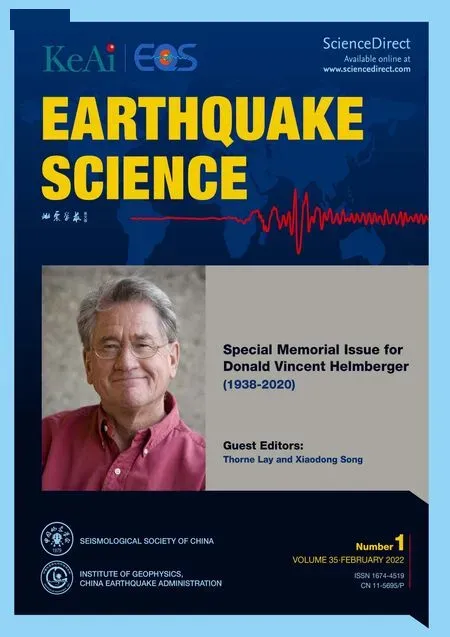Working and playing with Don: Memories of Donald V.Helmberger
David J. Wald
U.S. Geological Survey, Golden, Colorado 80401, USA
You might find it hard to believe, but I went to Caltech’s Seismological Lab for my Ph.D. on a football scholarship. Well, perhaps I should explain.
I received my M.S. in Geophysics (Earthquake Seismology) at University of Arizona in 1986, under the tutelage of Terry Wallace (Caltech Ph.D., 1983). Terry worked with Don prior to joining the faculty at the University of Arizona. And there the Helmberger stories began.
With Terry’s connections in California, I leveraged my Master’s degree in seismology into my first real job, at Woodward Clyde Consultants (WCC) in Pasadena,working with Paul Somerville and Larry Burdick (Caltech Ph.D., 1977). Larry’s repeated mantra to me was, “Respect the data,” a phrase that presumably came from his studies with Don a few years earlier, and one that has always stuck with me. Don happened to be a founding consultant at that WCC Pasadena office, and I worked with him regularly.Oh, and played.
Don led a league of one called “Helmberger Football.”I played intramural football previously as an undergrad;my size and speed made me suitable only as a receiver,and in my own mind, one of Don’s favorites. Don was a talented and athletic quarterback, and we loved to play together. When I applied only to Caltech for my Ph.D., and only to work with Don as my advisor, I somehow got in.The term “Helmberger Football,” by the way, reflected the fact that Don stacked the teams by his knowledge of the changing roster over the years and occasionally changed the rules in his favor—duringa game. His competitiveness came out on the field, sometimes resulting in a literal moving of the goalposts. But we did have fun.
Note I referred earlier to working “with” Don rather than “under” Don. He never pulled rank. Don was never intimidating or unkind, nor did he ever add pressure to what was otherwise a pressure-cooker of an experience at Caltech. His ability to play with his mentees, either with seismograms, over a beer, or on the football field, made for such a memorable experience that these words easily flow for me, and I smile just recollecting all this.
I don’t recall hearing the term “Doctor” or “Professor”Helmberger. Informality was the name of the game, and Don was Don, which was part of his approachability. His famous quirkiness was indeed a barrier to entry, and while that may have been a speedbump to some, it too was a lesson at the Lab—communicating with gifted people whose thoughts and ideas are way out ahead of their words.
What Don provided students was a haven to learn about the makeup of a seismogram, as if they held the keys to the universe. Whether from phases impinging on D”,reflecting off the 650 km discontinuity, the lithosphere, Pnl path through the crust, bouncing along the bottom of a basin, or those within the top 30 m; these were all ingredients that helped us understand at least the Earth …and Don. What Don didn’t provide was tutoring in writing papers or proposals, nor in preparing slides and talks; those lessons came collectively from others in the Llab,primarily our peers, whom I thank immensely as I think back (I would not have survived Physics 106 without help from my friend, Kuo-Fong Ma).
One’s success with Don depended on learning the critical ability to recognize the gems among the barrage of otherwise crazy ideas Don threw at you. Blessed with a flurry of earthquakes in my years at Caltech (1988–1992),every year I had another earthquake to study, and thus another thesis chapter (Wald, 1993). My work with Don was to resolve the spatial and temporal evolution of fault slip for each earthquake that came our way (Wald et al.,1990, 1991, 1992, 1993), with a full recognition of where the diagnostic waveforms came from and what circuitous paths they took. This might have gone on for years since we kept finding new ways to attack the problem. That is,until the 1992 Landers (M7.3) earthquake, and after chapter six, I’d had enough. After nearly four years, I was able to snatch the pebble from Don’s hand, and it was time to leave. Luckily, moving across the street to the U.S.Geological Survey (USGS) in Pasadena allowed me another dozen years on the Caltech campus with hundreds of coffee hours with Don and the wonderful cast of characters at the Lab who came and went. And more seismograms.
After moving to the USGS National Earthquake Information Center in Golden, Colorado, I routinely revisited our Pasadena office and would drop in on Don every time. As if nothing had changed, he would start talking about what was sitting on his desk in front of him.He showed no sign of slowing down, nor boredom—just the unending inquisitiveness of a man blessed with tremendous curiosity.
I would be remiss to not mention all the great lessons I learned from Don’s circle of influence and other students at the time, among them: Kuo-Fong Ma, Hong-Kie Thio,Monica Kohler, and colleagues Paul Somerville, Terry Wallace, Hiroo Kanamori, Tom Heaton, Steve Hartzell,Don Anderson, Rob Clayton, and Clarence Allen.
Whether my foray into the fantastic world of seismology with Don was due to my ability to catch a football or my passable knowledge of seismology learned during my Master’s program will remain a mystery with Don’s passing. But one way or the other, I got to work with Don Helmberger, and there, with Don, I thrived. I owe so much of my love and appreciation of seismology and scholarship to Don—both academic and football.Godspeed Don.
- Earthquake Science的其它文章
- How Donald V. Helmberger inspired me
- Donald V. Helmberger, the master mentor: Testimonials from former international students
- Donald V. Helmberger’s art and science of waveforms
- The Lost and the Found: Memories of Donald V.Helmberger
- Graduate studies with Donald V. Helmberger
- Exploring Earth’s boundaries with Donald V.Helmberger

